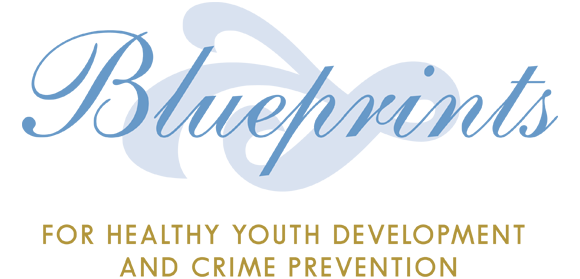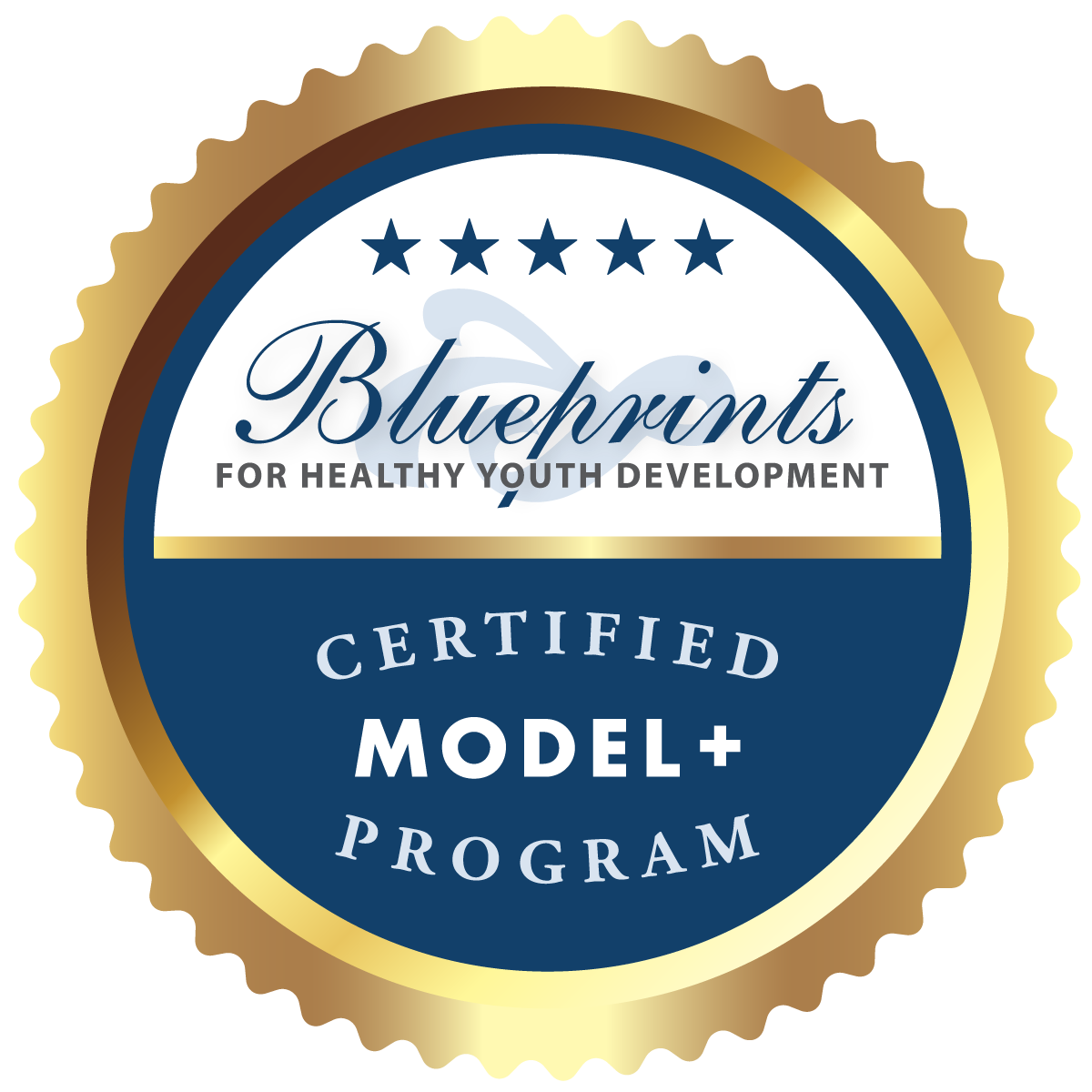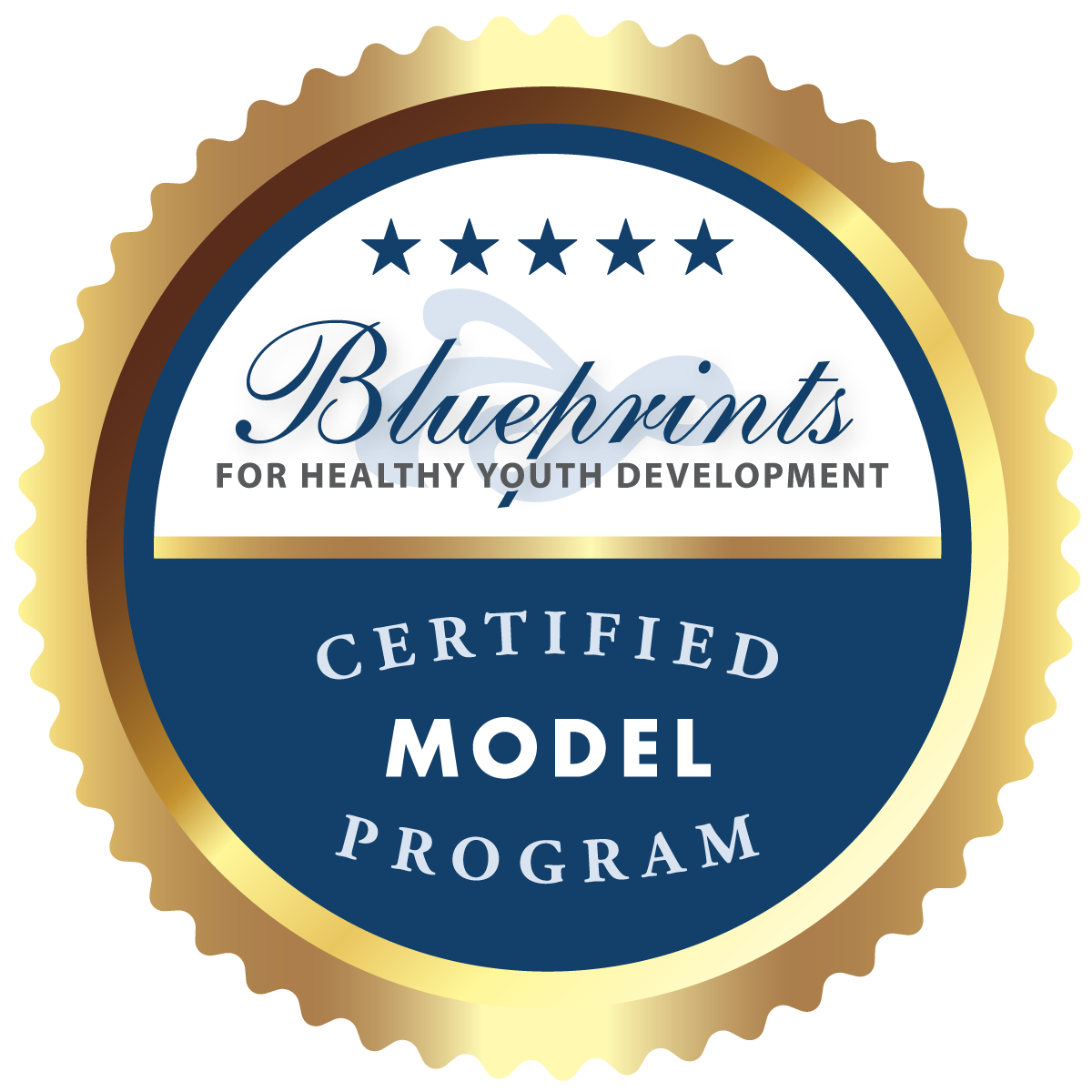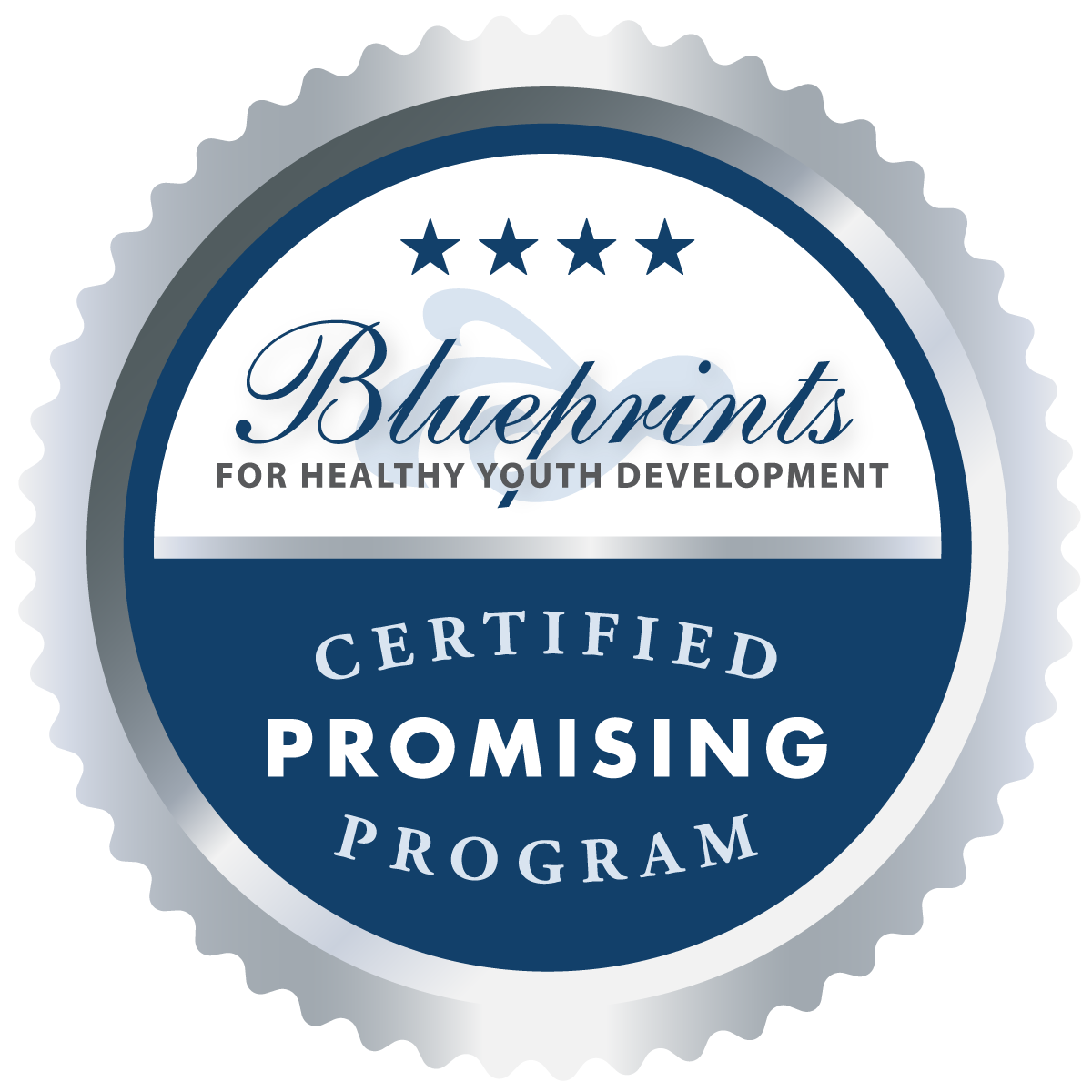
Program Search
This interactive search enables you to identify Blueprints-certified interventions based on specific criteria and then browse through a wide range of interventions that match those criteria. Select only a few criteria of importance, as the number of interventions may be reduced by selecting multiple items ACROSS categories, or increased by selecting multiple items WITHIN categories.
Model and Model Plus programs are listed separately from Promising programs. This is because only Model and Model Plus programs have demonstrated efficacy for changing outcomes over time and are recommended for large-scale implementation. Promising programs show promise of efficacy, but require follow-up research before being recommended for large-scale adoption.
26 Programs
| Program | Rating | Summary |
|---|---|---|
|
GenerationPMTO
|
 Model Plus
Model Plus
|
A family training program that aims to teach effective family management skills in order to reduce antisocial and problematic behavior in children through trainings implemented in a variety of formats and settings.
A family training program that aims to teach effective family management skills in order to reduce antisocial and problematic behavior in children through trainings implemented in a variety of formats and settings.
|
Target Population
Age: Early Childhood (3-4) - Preschool, Late Adolescence (15-18) - High School, Early Adolescence (12-14) - Middle School, Late Childhood (5-11) - K/Elementary |
||
|
Coping Power
|
 Model
Model
|
A preventative group intervention designed to reduce aggressive attitudes and behaviors and prevent substance abuse among at-risk children in the late elementary to early middle school years.
A preventative group intervention designed to reduce aggressive attitudes and behaviors and prevent substance abuse among at-risk children in the late elementary to early middle school years.
|
Target Population
Age: Late Childhood (5-11) - K/Elementary |
||
|
Family Check-Up - Early Childhood
|
 Model
Model
|
A parent training program that aims to prevent conduct problems among at-risk young children by improving the quality of parenting and increasing and maintaining parents' use of positive behavior support. A parent training program that aims to prevent conduct problems among at-risk young children by improving the quality of parenting and increasing and maintaining parents' use of positive behavior support. |
Target Population
Age: Early Childhood (3-4) - Preschool, Infant (0-2), Late Childhood (5-11) - K/Elementary |
||
|
Family Foundations
|
 Model
Model
|
A universal prevention program designed to improve birth outcomes, reduce family aggression, enhance child mental and behavioral health, and enhance parent mental and physical health through promoting coparenting quality among couples at the transition to parenthood. A universal prevention program designed to improve birth outcomes, reduce family aggression, enhance child mental and behavioral health, and enhance parent mental and physical health through promoting coparenting quality among couples at the transition to parenthood. |
Target Population
Age: Infant (0-2) |
||
|
Nurse-Family Partnership
|
 Model
Model
|
A nurse home visiting program for economically disadvantaged first-time pregnant mothers designed to improve prenatal and child rearing practices through the child's second birthday. A nurse home visiting program for economically disadvantaged first-time pregnant mothers designed to improve prenatal and child rearing practices through the child's second birthday. |
Target Population
Age: Infant (0-2) |
||
|
ParentCorps
|
 Model
Model
|
A multi-level intervention designed for pre-kindergarten children living in low-income neighborhoods to create safe, nurturing and predictable environments at home and in the classroom and improve relationships and communication between parents and teachers.
A multi-level intervention designed for pre-kindergarten children living in low-income neighborhoods to create safe, nurturing and predictable environments at home and in the classroom and improve relationships and communication between parents and teachers.
|
Target Population
Age: Early Childhood (3-4) - Preschool |
||
|
Strong African American Families Program
|
 Model
Model
|
An interactive educational program for African American parents and their early adolescent children living in rural communities that is designed to strengthen family relationships and help adolescents develop positive behaviors and respond effectively to the risks of substance use, delinquency, and sexual involvement. An interactive educational program for African American parents and their early adolescent children living in rural communities that is designed to strengthen family relationships and help adolescents develop positive behaviors and respond effectively to the risks of substance use, delinquency, and sexual involvement. |
Target Population
Age: Early Adolescence (12-14) - Middle School, Late Childhood (5-11) - K/Elementary |
||
| Program | Rating | Summary |
|---|---|---|
|
Bounce Back
|
 Promising
Promising
|
A school- and group-based program designed to improve symptoms of posttraumatic stress, depression, and anxiety among children with posttraumatic stress symptoms. A school- and group-based program designed to improve symptoms of posttraumatic stress, depression, and anxiety among children with posttraumatic stress symptoms. |
Target Population
Age: Late Childhood (5-11) - K/Elementary |
||
|
Child First
|
 Promising
Promising
|
A two-generation home visitation program which works to heal and protect young children and their families from the devastating effects of chronic stress and trauma. It provides psycho-therapeutic services and intensive care coordination, while building adult reflective and executive capacity, to prevent or diminish serious emotional disturbance, developmental and learning disabilities, and abuse and neglect among young children.
A two-generation home visitation program which works to heal and protect young children and their families from the devastating effects of chronic stress and trauma. It provides psycho-therapeutic services and intensive care coordination, while building adult reflective and executive capacity, to prevent or diminish serious emotional disturbance, developmental and learning disabilities, and abuse and neglect among young children.
|
Target Population
Age: Early Childhood (3-4) - Preschool, Infant (0-2) |
||
|
Culturally Informed and Flexible Family-Based Treatment for Adolescents (CIFFTA)
|
 Promising
Promising
|
A family therapy program for Hispanic parents and adolescents that aims to improve parenting and reduce adolescent substance use. A family therapy program for Hispanic parents and adolescents that aims to improve parenting and reduce adolescent substance use. |
Target Population
Age: Late Adolescence (15-18) - High School, Early Adolescence (12-14) - Middle School |
||
|
EFFEKT
|
 Promising
Promising
|
An alcohol prevention program designed to reduce teenage alcohol use through parent training.
An alcohol prevention program designed to reduce teenage alcohol use through parent training.
|
Target Population
Age: Early Adolescence (12-14) - Middle School |
||
|
Familias Unidas
|
 Promising
Promising
|
A family-based intervention to empower Hispanic immigrant parents to build a strong parent-support network and help their adolescent children respond effectively to the risks of substance use and unsafe sexual behavior. A family-based intervention to empower Hispanic immigrant parents to build a strong parent-support network and help their adolescent children respond effectively to the risks of substance use and unsafe sexual behavior. |
Target Population
Age: Late Adolescence (15-18) - High School, Early Adolescence (12-14) - Middle School |
||
|
Group Teen Triple P - Level 4
|
 Promising
Promising
|
A group parent training program designed to improve parenting skills, manage family problems, and enhance positive family relationships, ultimately to prevent problem behavior among youth.
A group parent training program designed to improve parenting skills, manage family problems, and enhance positive family relationships, ultimately to prevent problem behavior among youth.
|
Target Population
Age: Early Adolescence (12-14) - Middle School |
||
|
Guiding Good Choices
|
 Promising
Promising
|
A family competency training program that aims to enhance parenting behaviors and skills, to enhance effective child management behaviors and parent-child interactions and bonding, to teach children skills to resist peer influence, and to reduce adolescent problem behaviors.
A family competency training program that aims to enhance parenting behaviors and skills, to enhance effective child management behaviors and parent-child interactions and bonding, to teach children skills to resist peer influence, and to reduce adolescent problem behaviors.
|
Target Population
Age: Early Adolescence (12-14) - Middle School |
||
|
HighScope Preschool
|
 Promising
Promising
|
A preschool program that builds cognitive skills and attitudes for school success and aims to prevent adolescent delinquency and school dropout in the long term.
A preschool program that builds cognitive skills and attitudes for school success and aims to prevent adolescent delinquency and school dropout in the long term.
|
Target Population
Age: Early Childhood (3-4) - Preschool |
||
|
Incredible Years - Parent
|
 Promising
Promising
|
A group-based parenting program delivered in weekly sessions over 3-5 months that strengthens parent competencies to promote young children's social, emotional, and academic competence and prevent the development of conduct problems.
A group-based parenting program delivered in weekly sessions over 3-5 months that strengthens parent competencies to promote young children's social, emotional, and academic competence and prevent the development of conduct problems.
|
Target Population
Age: Early Childhood (3-4) - Preschool, Late Childhood (5-11) - K/Elementary |
||
|
KEEP SAFE
|
 Promising
Promising
|
A six-session group-based intervention, facilitated by paraprofessionals, for youth in foster care as they transition to middle school. The program aims to prevent internalizing and externalizing problems that may lead to more serious longer term outcomes such as delinquency, substance use, and high-risk sexual behavior. Foster parents also attend a six-session program.
A six-session group-based intervention, facilitated by paraprofessionals, for youth in foster care as they transition to middle school. The program aims to prevent internalizing and externalizing problems that may lead to more serious longer term outcomes such as delinquency, substance use, and high-risk sexual behavior. Foster parents also attend a six-session program.
|
Target Population
Age: Early Adolescence (12-14) - Middle School |
||
|
New Beginnings (for children of divorce)
|
 Promising
Promising
|
A group-based intervention for divorced parents to promote resilience in children after parental divorce. A group-based intervention for divorced parents to promote resilience in children after parental divorce. |
Target Population
Age: Late Adolescence (15-18) - High School, Early Adolescence (12-14) - Middle School, Late Childhood (5-11) - K/Elementary |
||
|
Parent-Child Interaction Therapy
|
 Promising
Promising
|
A program designed for children and their parents that focuses on decreasing child behavior problems, increasing positive parent behaviors, and improving the quality of the parent-child relationship.
A program designed for children and their parents that focuses on decreasing child behavior problems, increasing positive parent behaviors, and improving the quality of the parent-child relationship.
|
Target Population
Age: Early Childhood (3-4) - Preschool, Late Childhood (5-11) - K/Elementary |
||
|
Promoting First Relationships
|
 Promising
Promising
|
A training program for service providers in the use of effective strategies for promoting secure and healthy relationships between caregivers and young children birth to three years of age.
A training program for service providers in the use of effective strategies for promoting secure and healthy relationships between caregivers and young children birth to three years of age.
|
Target Population
Age: Infant (0-2) |
||
|
PROSPER
|
 Promising
Promising
|
A delivery system that attempts to foster implementation of evidence-based youth and family interventions, complete with ongoing needs assessments, monitoring of implementation quality and partnership functions, and evaluation of intervention outcomes.
A delivery system that attempts to foster implementation of evidence-based youth and family interventions, complete with ongoing needs assessments, monitoring of implementation quality and partnership functions, and evaluation of intervention outcomes.
|
Target Population
Age: Early Adolescence (12-14) - Middle School |
||
|
Raising Healthy Children
|
 Promising
Promising
|
A preventive intervention with teacher, parent, and child components, designed to promote positive youth development by enhancing protective factors, reducing identified risk factors, and preventing problem behaviors and academic failure.
A preventive intervention with teacher, parent, and child components, designed to promote positive youth development by enhancing protective factors, reducing identified risk factors, and preventing problem behaviors and academic failure.
|
Target Population
Age: Late Adolescence (15-18) - High School, Early Adolescence (12-14) - Middle School, Late Childhood (5-11) - K/Elementary |
||
|
SNAP® (Stop Now And Plan) Boys
|
 Promising
Promising
|
A cognitive behavioral multi-component training program designed to reduce antisocial behavior and/or police contact among boys at risk for such engagement by decreasing the factors that make children susceptible for continued delinquency and strengthening the protective factors of the parents, the child, and the family structure. A cognitive behavioral multi-component training program designed to reduce antisocial behavior and/or police contact among boys at risk for such engagement by decreasing the factors that make children susceptible for continued delinquency and strengthening the protective factors of the parents, the child, and the family structure. |
Target Population
Age: Late Childhood (5-11) - K/Elementary |
||
|
Strengthening Families 10-14
|
 Promising
Promising
|
A group parenting and youth skills program that aims to promote good parenting skills and positive family relationships; reduce aggressive, hostile behavior, and substance abuse in adolescence; and improve family relationships through weekly parent effectiveness training and child skills-building, followed by a family session.
A group parenting and youth skills program that aims to promote good parenting skills and positive family relationships; reduce aggressive, hostile behavior, and substance abuse in adolescence; and improve family relationships through weekly parent effectiveness training and child skills-building, followed by a family session.
|
Target Population
Age: Early Adolescence (12-14) - Middle School, Late Childhood (5-11) - K/Elementary |
||
|
Strong African American Families - Teen
|
 Promising
Promising
|
A family-centered group program for African-American teens living in rural communities that fosters skills for parenting, strengthens family relationships, and helps youth develop the self-regulation needed to respond effectively to risks of substance use and unsafe sexual behavior. A family-centered group program for African-American teens living in rural communities that fosters skills for parenting, strengthens family relationships, and helps youth develop the self-regulation needed to respond effectively to risks of substance use and unsafe sexual behavior. |
Target Population
Age: Late Adolescence (15-18) - High School |
||
|
Triple P System
|
 Promising
Promising
|
A public health approach to reach all parents in a community to enhance parental competence and prevent or alter dysfunctional parenting practices, thereby reducing family risk factors both for child maltreatment and for children's behavioral and emotional problems.
A public health approach to reach all parents in a community to enhance parental competence and prevent or alter dysfunctional parenting practices, thereby reducing family risk factors both for child maltreatment and for children's behavioral and emotional problems.
|
Target Population
Age: Early Childhood (3-4) - Preschool, Infant (0-2), Adult, Late Childhood (5-11) - K/Elementary |
||
 Program
Program